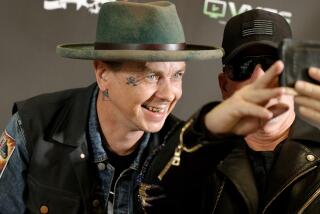Burn victim hopes to get a face transplant
- Share via
Reporting from Dallas — Dallas Wiens remembers standing in a cherry picker repairing a church window when his cellphone rang. The next thing he remembers is waking up three months later in the burn unit of a Dallas hospital.
His family told him his head touched a high-voltage power line that day in November 2008. The jolt seared off his face.
By the time he was awakened from an induced coma last February, Wiens had been through more than 20 surgeries and his face had become a smooth, featureless melon of skin and muscle harvested from elsewhere on his body.
Where his eyes and nose had been were slight indentations. His upper lip and the roof and inside of his mouth were gone, as were most of his teeth.
But his survival amazed doctors and inspired his family.
Now Wiens, 24, hopes to get a face transplant, a procedure so rare and risky that only a handful have been done successfully in the world.
“I understand the risks,” he said. “But if I opt for a transplant, I figure what I’ve already lived through is far worse.”
Wiens hopes to be treated at Brigham and Women’s Hospital in Boston, where doctors successfully transplanted a face onto a burned man in April.
“It’s a long shot,” said Dr. Jeffrey Janis, his plastic surgeon in Texas.
His other option is facial reconstruction that would use prosthetic or artificial parts, including a nose and eyes, as well as a hair transplant and lip reconstruction.
Wiens must undergo a rigorous screening process at the Boston hospital, where James Maki, 59, underwent a successful face transplant last year.
Dr. Bohdan Pomahac, the lead surgeon in that case, said facial transplants give severely deformed people an opportunity to rejoin society.
“It is hard for us to imagine how difficult it was for Jim. He feared going outside,” the surgeon said last year. “I feel that we are here on a mission, using cutting-edge technology to restore patients’ lives.”
Wiens has no fear of being out in public because he cannot see how people react. But he knows they often are startled.
“One woman got right up in his face and looked under his cap, like she couldn’t believe what she was seeing. It was so rude,” said Sue Peterson, Wien’s grandmother.
Wiens doesn’t let such reactions spoil his positive attitude.
“I’ve let go of the illusion of control,” he said. “You can’t control everything, and when you try, you just get frustrated.”
His upbeat personality is a far cry from the way he was before the accident. Growing up in Fort Worth, he was better known for causing trouble for his parents and two older brothers.
His problems forced him to graduate from a home-schooling program rather than high school. He’s had minor brushes with the law but no convictions. And he’s in the process of ending a two-year marriage.
He spent nine months in the Army before receiving an honorable medical discharge in 2006 because of knee problems.
“From the time I was 14, I consciously walked a path of turmoil,” Wiens said. “The only thing good that came out of it was my daughter.”
Wiens and his grandparents are attempting to get primary custody of Scarlette, 2. Wiens lives with the couple in their modest Fort Worth home.
“We wanted to be available to help Dallas with whatever he needed and to help him raise Scarlette. She is the light of his life,” said his grandmother, who retired from teaching when Wiens was discharged from the hospital in May. His grandfather, Delton, also retired from his job as a banker.
After his injury, doctors expected Wiens to be paralyzed from the neck down and never walk, talk or eat regular food again. His family was told that he would probably not survive.
Wiens ended up joking with the doctor who had given him such a grim prognosis.
“I told him, ‘If you have anything else you think I won’t do, please tell me now so I can try to do it,’ ” Wiens said. “The doctor said I wouldn’t be doing push-ups. I’m up to 15 already.”
Jacobson writes for the Dallas Morning News.
More to Read
Sign up for Essential California
The most important California stories and recommendations in your inbox every morning.
You may occasionally receive promotional content from the Los Angeles Times.










